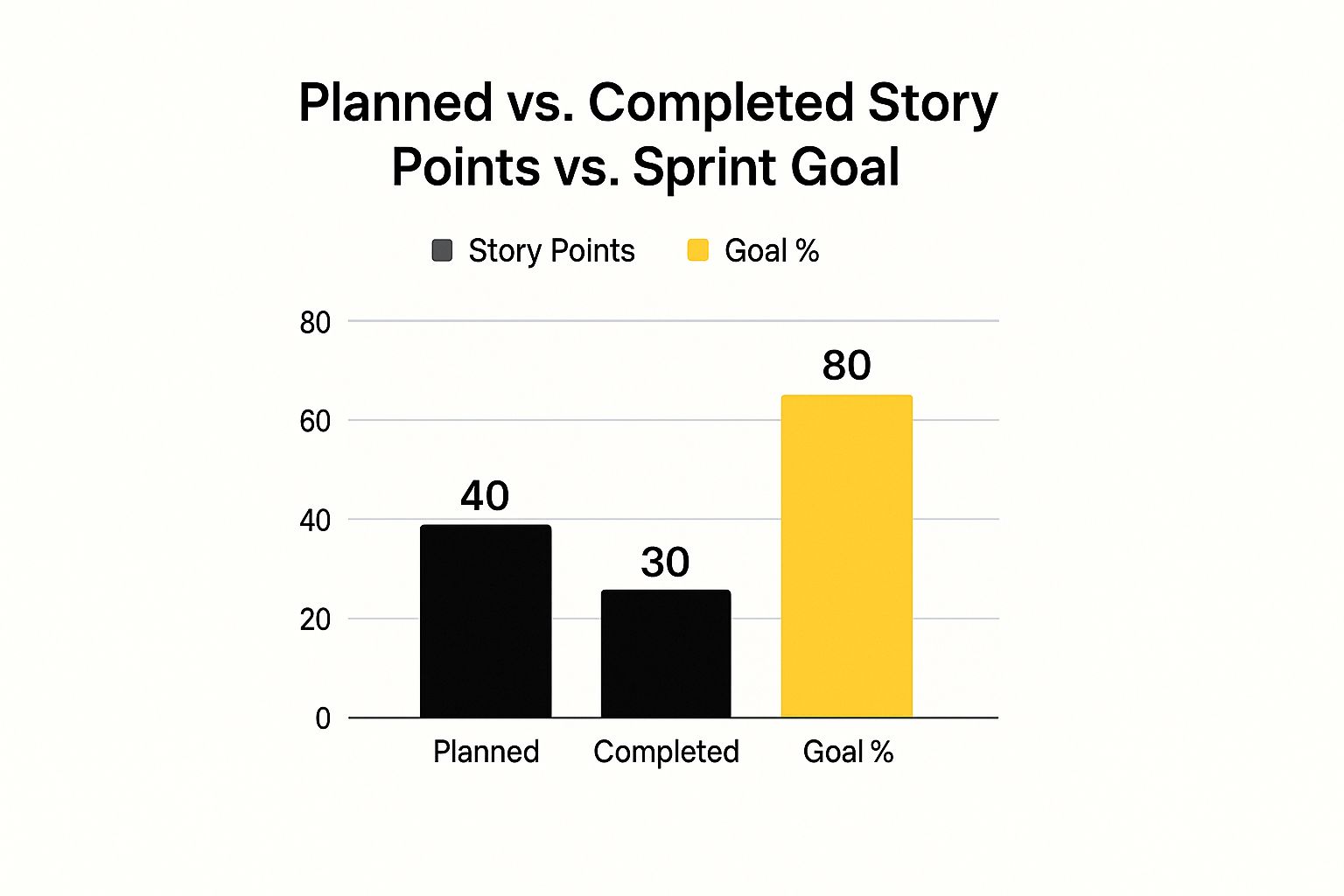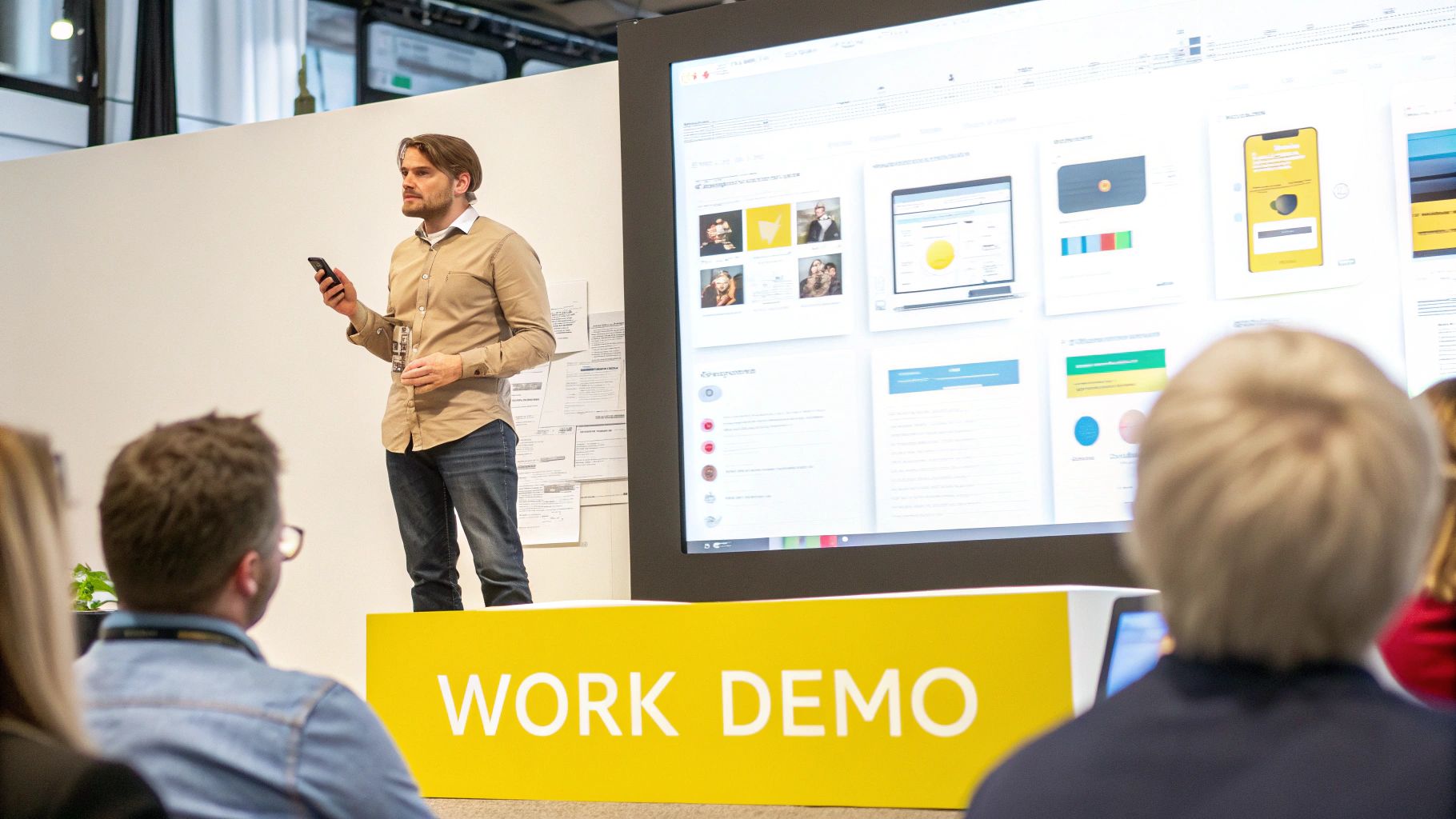Why Most Sprint Reviews Fall Flat (And How To Fix Yours)

Let’s be frank, many sprint reviews end up feeling like a status update rather than a genuine discussion. Stakeholders see them as a chore, and the team’s enthusiasm dwindles. This can have a knock-on effect, impacting the product’s direction and the project’s overall success. One frequent culprit? A lack of clear goals and a solid team structure. For more on team structures, check out this article on why some development teams fail.
But I’ve also seen the flip side. I’ve seen sprint reviews become events that stakeholders actually look forward to – actively engaging and offering invaluable insights. There’s no secret sauce here, just thoughtful planning and execution. These successful teams use the sprint review agenda as a strategic tool, not just a checklist.
The key to this transformation is understanding the core purpose of a sprint review. It’s not just about showing what you’ve finished; it’s about building shared understanding and gathering crucial feedback. This shifts the focus from checking off tasks to showcasing the value delivered and sparking meaningful conversations. This change in perspective is vital for a truly energizing and valuable sprint review. Want to learn more about effective Scrum meetings? Our guide on essential Scrum meetings can help.
Sprint review meetings are now a cornerstone of agile project management, especially in the tech world. According to the Scrum Guide, followed by over 80% of agile teams worldwide, a sprint review is a must. It can take up to four hours for a month-long sprint, with shorter sprints needing less time. A 2020 Scrum Alliance survey revealed that 86% of Scrum teams hold regular sprint reviews, highlighting their importance in keeping product increments aligned with stakeholder expectations. Discover more insights about sprint reviews. This widespread adoption really emphasizes the value of sprint reviews in boosting transparency and organizational agility.
Creating a powerful sprint review involves more than just listing completed tasks. It’s about telling a story, explaining the “why” behind the “what,” and demonstrating how the work gets the product closer to its overarching goals. This approach transforms the meeting from a dry report into a dynamic and informative discussion, getting stakeholders genuinely invested in the product’s journey.
Building An Agenda That Keeps Everyone Awake
Let’s be honest, nobody enjoys a sprint review that’s just a monotonous list of completed tasks. A well-structured agenda is your secret weapon for a productive and engaging session. Forget generic templates – we’re talking about crafting something tailored to your team’s specific needs. Think of it like planning a killer dinner party: you need the right ingredients and perfect timing to make it memorable.

This chart gives you a quick snapshot of your planned story points, completed story points, and overall sprint goal achievement. Visualizing this data helps you understand your team’s velocity and how effectively you’re meeting your objectives. For example, a noticeable gap between “Completed” and “Planned” story points is a clear sign of potential roadblocks that need addressing.
In my experience working with high-performing teams, dedicating specific time slots for different activities is a game-changer. This could mean allocating 30-40% of the meeting to demos, 20-30% to Q&A, and the rest to discussing next steps. This structured approach keeps things focused, ensures every crucial element is covered, and respects everyone’s time. And speaking of structure, studies show that teams with well-structured sprint review agendas see a 42% increase in responsiveness and quality. Want to dive deeper into those stats? Discover more insights about agile statistics.
Customizing Your Sprint Review Agenda
Remember, your sprint review agenda isn’t etched in stone. It’s a living document you can adjust based on your project’s complexity, your team’s maturity level, and even stakeholder personalities. A complex project might require a longer Q&A, while a seasoned team might need less time for process discussion.
Don’t be afraid to inject some interactive elements, too. Quick polls using tools like Mentimeter, brainstorming sessions, or even a mini-retrospective on the sprint itself can boost engagement and uncover valuable insights beyond the typical presentations. For some inspiration from a team known for their agile practices, check out this article: Unlocking Agile Success: Mastering Sprint Reviews with NASA.
Time Management and Flexibility
While structure is key, flexibility is its equally important counterpart. Things happen! Demos can run long, and critical discussions sometimes need more time than you initially planned. A skilled facilitator anticipates these hiccups and has strategies to handle them smoothly. A “parking lot” for off-topic discussions, for instance, keeps the meeting focused while acknowledging valuable contributions. This creates a balance that allows for productive conversation without derailing the meeting’s objectives.
To help you visualize this balance, here’s a handy guide:
Sprint Review Agenda Time Allocation Guide
Optimal time distribution for different sprint review meeting components based on meeting duration.
| Meeting Component | 30-min Sprint | 60-min Sprint | 90-min Sprint | Percentage of Total |
|---|---|---|---|---|
| Demo | 10-12 min | 20-24 min | 30-36 min | 30-40% |
| Q&A | 6-9 min | 12-18 min | 18-27 min | 20-30% |
| Discussion & Next Steps | 9-12 min | 18-24 min | 27-36 min | 30-40% |
This table provides a starting point. You can adjust these percentages based on your team’s specific needs and the nature of the sprint. The key takeaway here is to have a framework that allows for both focused discussion and adaptable timing.
The Prep Work That Makes Everything Click
Great sprint reviews don’t just magically appear. They’re the product of solid planning. The difference between a sprint review that gets stakeholders excited and one that puts them to sleep often boils down to the behind-the-scenes work. It’s like a successful product launch – the heavy lifting happens way before the unveiling.
This screenshot from Atlassian highlights the core elements of a successful sprint review agenda. It emphasizes showing off the work, gathering feedback, and adjusting the product backlog accordingly. The visual reminds us that the review is a collaborative process, playing a crucial role in iterative development.

Look at how the image shows a team actively participating in the review. This really drives home how important it is to create a comfortable environment for everyone to contribute and share their thoughts. When you’re putting together your sprint review agenda, think about incorporating some general web development best practices.
Setting the Stage for Success
Seasoned Product Owners know the value of laying the groundwork. Getting input from key stakeholders beforehand can drastically improve the review. A quick email or a short chat to understand their priorities and concerns allows you to tailor the presentation and anticipate questions. This also avoids the sprint review becoming a total ambush.
Prepping the Development Team is just as important. Rehearsing demos isn’t about memorization; it’s about smooth transitions, highlighting key features, and anticipating any technical bumps in the road. This boosts the team’s confidence and lets them focus on showing the value of their work, not frantic troubleshooting. Also, proactively addressing any unfinished work – with clear explanations and proposed next steps – shows transparency and builds trust with stakeholders.
Handling the Unexpected
Part of a good sprint review strategy is planning for the curveballs. Create a list of potentially tricky questions and think about how you’ll answer them. This preparation helps you address concerns with confidence and keeps the conversation productive. For instance, if a feature wasn’t finished, having a clear explanation ready, along with a plan to tackle it, reassures stakeholders that you’re in control. This proactive approach can prevent small setbacks from snowballing into major issues.
Setting clear expectations for the review is another key pre-meeting task. Let everyone know the purpose beforehand, emphasizing that it’s about feedback on the completed sprint, not a redesign session. This keeps scope creep from hijacking the agenda. You also might want to refresh your sprint planning skills. This guide might help: Your ultimate guide to sprint planning. Finally, don’t overlook the technical side. Testing equipment, making sure remote participants can connect, and having backup plans for technical glitches can prevent last-minute scrambling and keep things running smoothly.
Facilitating Conversations That Move Things Forward

A truly productive sprint review meeting rests on the facilitator’s shoulders. It’s about creating a comfortable atmosphere where everyone feels safe contributing, even when disagreements arise. Think of it less like a formal presentation and more like a lively dinner party – you want everyone engaged in a good conversation. This requires more than just sticking to the agenda; it requires active listening, thoughtful questions, and the ability to steer the discussion in the right direction.
Encouraging Meaningful Participation
One of the trickiest parts of facilitation is balancing everyone’s contributions. You’ll inevitably have some stakeholders eager to share every thought, while others might be hesitant to speak up. A solid sprint review prep process can help, and a good pull request template can be a surprisingly useful tool in creating a helpful checklist. As the facilitator, you can draw out the quieter folks with direct questions like, “What are your thoughts on this feature?” or “From a marketing perspective, how does this align with our goals?”
For the more vocal participants, acknowledge their input but gently guide the conversation back to the agenda to keep things on track. Try phrases like, “That’s a great point, let’s circle back to that after we cover the core demo.”
Managing Difficult Situations
Let’s face it, sometimes things just go sideways. The demo crashes, a stakeholder challenges the entire product direction, or team members have a public disagreement. These are the moments that truly test a facilitator’s mettle. The key is to stay calm and focused.
A crashed demo? Acknowledge the issue, quickly shift to a backup plan (screenshots or a pre-recorded video are lifesavers), and schedule a dedicated time for a proper demo follow-up. When faced with tough criticism, reframe the conversation towards constructive feedback. Instead of getting defensive, ask clarifying questions like, “Can you elaborate on what specifically doesn’t meet your expectations?” This shifts the focus from assigning blame to finding solutions.
Navigating Cultural Differences
With distributed teams, cultural differences can add another layer of complexity. Direct feedback might be seen as rude in some cultures, while others thrive on open debate. A skilled facilitator understands these nuances and adjusts their approach accordingly. Creating a psychologically safe space is paramount.
This means encouraging respectful communication, acknowledging different perspectives, and ensuring everyone feels heard, regardless of their background. This builds trust and promotes open communication, which ultimately leads to more productive and insightful sprint reviews. Remember, the ultimate goal is to gather diverse perspectives and turn them into actionable insights that benefit both the product and the team.
Making Stakeholders Care About Your Sprint Reviews
Let’s be honest, stakeholders are busy. They’re juggling projects, deadlines, and probably a mountain of emails. So how do you make your sprint review stand out? You can’t just send a calendar invite and hope for the best. You have to make it worth their time. I’ve seen teams struggle with this, but I’ve also seen the amazing results when they finally figure it out.
One of the best ways to grab their attention? Tell a story. Don’t just give a status report. Think about it – would you rather listen to someone drone on about completed tasks, or hear a compelling narrative about how those tasks are pushing the product forward? This approach brings the technical work to life and shows its impact on the bigger picture. It’s about showcasing the value, not just the features.
This storytelling approach gets even better when you make it interactive. Don’t let stakeholders be passive observers. Get them involved! Ask thought-provoking questions, get their opinions, and let them play with the product. Tools like polls or quick brainstorming sessions can gather real-time feedback and spark some great discussions. This turns the sprint review from a one-way presentation into a collaborative experience, making it more engaging and memorable. For more tips on engaging stakeholders, check out this article on project kickoff agendas: 7 Must-Haves for Your Project Kickoff Agenda in 2025.
Connecting Sprint Outcomes to Business Objectives
The best Product Owners I know are masters at connecting the dots between what the team built in the sprint and the overall business objectives. They don’t just show what was built; they explain why it matters. For example, instead of saying, “We finished the new search filter,” they’ll say something like, “This new search filter will improve user experience, which will lead to increased engagement and, ultimately, higher conversion rates.” This links the technical win to a real business impact, making it instantly relevant to stakeholders.
Development Teams can do the same. Focus on the “so what?” Skip the technical jargon and explain how your work solves a user problem or contributes to a strategic goal. This makes technical accomplishments understandable and meaningful for a non-technical audience.
Gathering Actionable Feedback and Managing Conflict
A good sprint review isn’t just about showing off your wins; it’s about getting valuable feedback. Have a structured way to collect input, whether it’s through a Q&A, a feedback form, or a collaborative brainstorming session. And remember, not all feedback will be sunshine and rainbows. Disagreements happen, and that’s okay. The trick is to manage those differing opinions constructively. Facilitate open discussion, encourage respectful communication, and focus on finding solutions that align with the product vision.
Turning stakeholder insights into a clear product direction is the final step. After the sprint review, take time to process the feedback, find the key themes, and translate them into actionable next steps. This shows you value stakeholder input and are committed to using their insights in the product roadmap. This builds a sense of shared ownership and keeps the team energized to deliver value. It makes sure the sprint review isn’t just a meeting, but a driver for continuous improvement and stakeholder alignment.
To help you think about different ways to engage your stakeholders and the impact on feedback quality, take a look at this comparison:
Stakeholder Engagement Techniques Comparison
Different approaches to maximize stakeholder participation and feedback quality in sprint reviews
| Technique | Best For | Preparation Required | Engagement Level | Feedback Quality |
|---|---|---|---|---|
| Presentation & Q&A | Large groups, formal updates | High – detailed slides, prepared remarks | Moderate – questions limited to Q&A | Can be superficial, limited depth |
| Interactive Demo | Smaller groups, hands-on experience | Medium – working demo, prepared scenarios | High – direct interaction with the product | More specific, user-focused |
| Collaborative Workshop | Deep dives, brainstorming, problem-solving | High – structured activities, clear objectives | Very High – active participation, co-creation | Rich insights, actionable feedback |
| Feedback Form | Gathering structured data, asynchronous input | Low – design and distribute form | Low – passive participation | Can be quantitative and qualitative, but lacks depth |
This table highlights some key differences in stakeholder engagement methods. Think about your audience and what kind of feedback you’re looking for to choose the right approach. While a presentation and Q&A might be suitable for a large, formal update, a collaborative workshop will provide richer, more actionable feedback. Each method has its place, so choose wisely!
When Sprint Reviews Go Sideways (And How To Recover)
Even the most meticulously planned sprint review can go off the rails. It’s like a well-rehearsed play – sometimes, despite all the preparation, the spotlight malfunctions or an actor forgets their lines. As the facilitator, it’s how you handle these unexpected hiccups that truly matters. From crashing demos to stakeholders attempting a complete product redesign, the potential roadblocks are numerous. Let’s explore some proven recovery strategies.
Technical Difficulties and Unexpected Questions
The dreaded demo fail is a common, and often stressful, occurrence. Picture this: you’re showcasing a crucial feature, and then…poof! The screen freezes, the connection drops, the room goes silent. Take a deep breath. This is where your backup plan shines. Always have screenshots, pre-recorded videos, or even a whiteboard ready. Calmly acknowledge the issue, switch to your backup, and schedule a dedicated follow-up demo.
Another common curveball is the tough question you didn’t anticipate. Perhaps a stakeholder challenges a design choice or the value of a feature. Instead of becoming defensive, try to understand their perspective. Ask clarifying questions like, “Can you elaborate on your concern?” or “Help me understand your point of view.” This shifts the conversation from confrontation to collaboration and opens the door for constructive feedback.
Managing Scope Creep and Harsh Feedback
Scope creep is a constant threat during sprint reviews. A stakeholder, excited by the demo, starts suggesting new features or design changes outside the original scope. Here, clear communication and gentle redirection are crucial. Acknowledge their input, but firmly reiterate the sprint goals and explain that new ideas need to be prioritized through the product backlog process. A simple phrase like, “That’s a great suggestion! Let’s document that and discuss it in our next backlog refinement session” can work wonders.
Sometimes, feedback goes beyond constructive and becomes harsh. A stakeholder might publicly criticize the team’s work or even question their competence. This can be demoralizing, especially for junior team members. Your role is to protect the team and guide the conversation back to respectful dialogue. Address the criticism directly but constructively. Try something like, “I appreciate your feedback, but let’s focus on specific areas for improvement instead of generalizing about the team’s performance.” Our guide on retrospectives might also be helpful: Mastering the Retrospective in Sprint: Best Practices and Tips.
Remote Meeting Challenges and Hybrid Audiences
Remote and hybrid meetings bring their own set of challenges. Technical glitches are more frequent, time zone differences can complicate scheduling, and maintaining engagement with a dispersed audience can be tough. Proactive communication is key. Test your technology beforehand, clearly communicate participation expectations, and incorporate interactive elements like polls, Q&A sessions, and virtual breakout rooms.
A backup plan is essential, such as a shared document for capturing feedback, in case technology fails. Even with perfect technology, fostering inclusion for remote participants takes extra effort. Acknowledge their presence, address them directly, and create opportunities for equal contribution. These small gestures can make a big difference in making everyone feel valued and heard.
Knowing If Your Sprint Reviews Actually Work
So, you’ve given your sprint review agenda a makeover. Fantastic! But how do you know if it’s really making a difference? Just having everyone in the room isn’t a sign of success. Trust me, I’ve sat through countless packed sprint reviews where everyone was secretly checking emails or just counting down the minutes. That’s not what we want. A truly effective sprint review leaves stakeholders feeling excited and the team aligned on the next steps. How can you tell if you’re hitting the mark?
Gathering Honest Feedback
Getting honest feedback is key. Anonymous surveys are your friend here. A tool like SurveyMonkey makes it easy to create quick polls with targeted questions like, “How valuable was this sprint review?”, “Did you feel heard?”, and “Did the agenda allow for meaningful discussion?”. Don’t be afraid to add open-ended questions too – they often uncover valuable insights. This kind of direct feedback, particularly when it’s anonymous, can expose blind spots and highlight areas that need attention.
Identifying Patterns and Making Data-Driven Adjustments
After gathering feedback, look for recurring themes. Are stakeholders consistently saying the demos are too technical? Are team members feeling like their input isn’t valued? These patterns are gold – they show you exactly where your sprint review is falling short. Use this data to make smart changes to your agenda and how you run the review. If stakeholders want more context, maybe weaving more storytelling into the demos could help.
Spotting Warning Signs and Revitalizing Stale Meetings
Low attendance is a glaring red flag, sure. But other, more subtle signs indicate your sprint reviews might be losing steam. A lack of active participation, the same questions popping up every time, or a general sense of apathy – these all point to the need for a refresh. Don’t let your sprint reviews become just another meeting. Try new formats, add interactive elements, or even switch up who facilitates. Small tweaks can sometimes make a world of difference.
Evolving Your Approach as Your Team Matures
As your product and team grow, so should your sprint review. What worked for a small, co-located team might not be right for a larger, distributed one. Regularly revisit your agenda and ensure it still fits your team’s current needs and the project’s complexity. A seasoned team might thrive with shorter, laser-focused reviews, while a newer team might need more time for discussion and feedback.
By constantly evaluating and adapting, you can keep your sprint reviews effective and engaging throughout the project lifecycle. They’ll become a crucial part of your team’s success, driving collaboration and keeping everyone on the same page.
Ready to turn your team meetings from time-suckers into strategic drivers? Check out resolution’s NASA – Not Another Standup App to streamline your sprint reviews, boost engagement, and get better results. Learn more about NASA and revolutionize your meetings!
